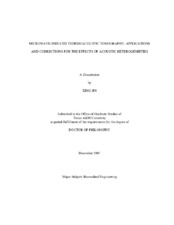| dc.contributor.advisor | Meissner, Kenith | |
| dc.contributor.advisor | Wang, Lihong | |
| dc.creator | Jin, Xing | |
| dc.date.accessioned | 2010-01-15T00:09:37Z | |
| dc.date.accessioned | 2010-01-16T00:33:11Z | |
| dc.date.available | 2010-01-15T00:09:37Z | |
| dc.date.available | 2010-01-16T00:33:11Z | |
| dc.date.created | 2007-12 | |
| dc.date.issued | 2009-05-15 | |
| dc.identifier.uri | https://hdl.handle.net/1969.1/ETD-TAMU-2440 | |
| dc.description.abstract | This research is primarily focused on developing potential applications for microwaveinduced
thermoacoustic tomography and correcting for image degradations caused by
acoustic heterogeneities. Microwave-induced thermoacoustic tomography was first used
to verify the feasibility of noninvasively detecting the coagulated damage based on
different dielectric properties between normal tissue and lesion treated with high
intensity focused ultrasound. Good image contrasts were obtained for the lesions. A
comparison of the size of the lesion measured with microwave-induced thermoacoustic
tomography and the size measured by a gross pathologic photograph was presented to
verify the effectiveness the proposed method. Clinical data for breast tumors were also
collected to verify the feasibility of using microwave-induced thermoacoustic
tomography in breast cancer imaging. Next, the effects of acoustic heterogeneities on
microwave-induced thermoacoustic tomography in weakly refractive medium were
investigated. A correction method based on ultrasonic transmission tomography was
proposed to correct for the image distortion. Numerical simulations and phantom experiments verify the effectiveness of this correction method. The compensation is
important for obtaining higher resolution images of small tumors in acoustically
heterogeneous tissues. Finally, the effects of the highly refractive skull on transcranial
brain imaging were studied. A numerical method, which considered wave reflection and
refraction at the skull surfaces, was proposed to compensate for the image degradation.
The results obtained with the proposed model were compared with the results without
considering the skull-induced distortion to evaluate the skull-induced effects on the
image reconstruction. It was demonstrated by numerical simulations and phantom
experiments that the image quality could be improved by incorporating the skull shape
and acoustic properties into image reconstruction. This compensation method is
important when the thickness of skull cannot be neglected in transcranial brain imaging. | en |
| dc.format.medium | electronic | en |
| dc.format.mimetype | application/pdf | |
| dc.language.iso | en_US | |
| dc.subject | Thermoacoustic | en |
| dc.subject | acoustic heterogeneities | en |
| dc.title | Microwave-induced thermoacoustic tomography: applications and corrections for the effects of acoustic heterogeneities | en |
| dc.type | Book | en |
| dc.type | Thesis | en |
| thesis.degree.department | Biomedical Engineering | en |
| thesis.degree.discipline | Biomedical Engineering | en |
| thesis.degree.grantor | Texas A&M University | en |
| thesis.degree.name | Doctor of Philosophy | en |
| thesis.degree.level | Doctoral | en |
| dc.contributor.committeeMember | Kuchment, Peter | |
| dc.contributor.committeeMember | Yeh, Alvin T. | |
| dc.type.genre | Electronic Dissertation | en |
| dc.type.material | text | en |
| dc.format.digitalOrigin | born digital | en |


